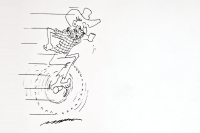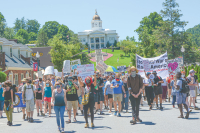Unearthing clues: Future crime solvers get hands-on training at Western
When a hunter discovered human skeletal remains in the woods in Macon County last winter, investigators didn’t know who the dead person was, how long he’d been there or if foul play was involved.
It was a classic situation for deploying forensic anthropology, the scientific side of crime scene analysis, to solve the puzzle.
Eventually, DNA and dental records helped identify the body as missing hiker John Bryant, 79, believed to be shot to death by serial killer Gary Hilton. Hilton, a Georgia drifter who targeted hikers, allegedly kidnapped Bryant in October 2007 while hiking in the Pisgah National Forest, but his body wasn’t found until February.
The field of forensic anthropology has taken center stage in crime solving in recent years. Law enforcement has been eager to capitalize on the latest scientific capabilities, juries have demanded it and state crime labs have grown exponentially. (see related article)
In response, Western Carolina University has launched a program in forensic anthropology to fill the need for trained workers in the field.
John Williams, forensic anthropology program director at WCU, said there’s another reason it’s a “hot field” right now: TV shows like “CSI” and “Bones” have romanticized the profession (although Williams said he avoids the shows).
“They are Hollywood’s view on how crimes are solved,” he said. “We don’t dress like that and drive Humvees.”
Unlike the action-packed way forensics is presented on TV, there is a lot of tedious work.
“There is a lot of boredom involved,” Williams said.
Forensics is a field for people who have investigative minds and like to solve puzzles, Williams said.
Williams has worked in forensics on murders, missing person cases, plane crashes and helped with victim ID at the World Trade Center after 9/11. He has done work for the FBI, medical examiners’ offices, and sheriff’s offices. He’s worked about seven murders.
Studying human corpses
Western is unique in its forensics program because it has a facility where corpses are dumped and allowed to decompose so students can study them.
The site provides invaluable experience for forensic students. They get to work hands on with an actual human corpse and see the rate of decomposition.
The research at Western will give a better understanding of how bodies decompose in the North Carolina mountains.
Williams and Assistant Professor of Anthropology Cheryl Johnston gave The Smoky Mountain News a tour of the facility but asked that its exact location not be revealed, other than across N.C. 107 from the Western campus. A tall fence with barbed wire on top surrounds the facility. It is on state land and measures about 50 feet by 50 feet.
The facility is often called the “body farm.” But Williams prefers not to call it that, saying it has a negative connotation. He prefers Forensic Osteology Research Station.
When the site opened about two years ago, Western was only the second school in the nation to have such a facility after the University of Tennessee. The University of Texas at San Marcos has now opened one as well, Williams said.
There is only one body at Western’s facility. The man, who is from out of state, requested that his body be donated to the University’s forensic program.
Williams would not identify the donor.
The man decomposed a lot since arriving at the site in June. His skeleton is basically all that remains. He is still wearing his blue jeans.
The man died suddenly of natural causes nine months ago, Williams said.
Insects that land on the body are also studied to better understand decomposition.
Williams does not know how the man who donated his body learned about the forensics program at Western, but said he may have read about it in the media.
In fact, Williams said he gets inquiries at least once a week from people thinking about donating their bodies to the program.
Those interested should contact Williams.
He noted that it is a serious decision to donate one’s body to the program. Giving up your body is “personal” and “generous,” he said.
An Interest in Death
The forensic anthropology instructors at Western have fascinating backgrounds working in the field.
Williams worked after 9/11 as part of DEMORT — a federal agency that goes to mass fatality situations. He was assisting the New York City Police Department in identifying victims.
In another case Williams said he was an expert witness in a civil case in Georgia against a crematory operator who was guilty of giving relatives of the deceased dust instead of the actual ashes.
Instructor Johnston worked on a case involving endangered species.
A vendor at a state fair in Ohio was selling orangutan skulls. The man said the skulls were imported from Borneo as antiquities.
Johnston found evidence that the skulls were not that old. The bone was waxy, not dried out. And there was evidence that the orangutans had been beheaded.
There was also a pig tooth in one of the tooth slots. It looked like someone had tried to put the skull back together so it would sell.
She worked that case for the U.S. Fish and Wildlife Service. The man was not arrested but the orangutan skulls were seized.
In another case in Ohio the coroner had identified bones found under a porch as belonging to a child and an adult.
When Johnston read about the case in the newspaper and saw pictures of the bones, she knew they weren’t human, but cow, pig, deer, and chicken bones. She informed the sheriff, and the case was dropped.
Johnston said her husband believes a childhood incident spurred her interest in forensics. She was five years old and a large airplane crashed near her relative’s yard.
Body parts were everywhere, she said. Officials were covering the limbs with towels, and Johnston was curious.
“I asked ‘what is that,’” she said.
The biological aspect of death is what interests her.
The most interesting case she worked was in Ohio involving a man buried in the woods.
The body had been buried for 12 years in a 6-foot grave.
A barrel had been placed on top of the body to keep the ground from caving in and revealing the grave.
Agricultural lime had been put in the grave, apparently because the perpetrator thought it would decompose the body.
Quick lime will decompose a body, but the agricultural lime combined with the ground water and formed a cocoon that preserved the skin while the inside of the body, except for the bone, decomposed.
Another case in Ohio she recalls involved a dysfunctional family in the country with about 11 children. The parents were alcoholics and had scalded one of the children in a hot bath, killing the child.
One of the child’s bones was found in a fire pit two or three years later. The director of the social services department in the area lost his job for letting the child fall through the cracks, she said.
Johnston noted that some forensic anthropologists do human rights work by identifying victims of war atrocities. By creating a historical record of those killed, regimes cannot deny that the atrocities took place. Bosnia and Rwanda are areas where this type of work has taken place, Johnston said.
There is a facility in Hilo, Hawaii, where forensic anthropologists help identify U.S. military war dead and repatriate them back to their families.
Real world skills
Johnston said there are plenty of jobs for people wanting to get into the field.
“It’s not like we’re going to quit killing each other,” she said.
With a master’s degree in the field, students can go into careers with medical examiners’ offices and crime labs, and identify war dead.
With a bachelor’s in forensic anthropology, students can work in law enforcement, Williams said.
Students in Johnston’s human osteology class at Western want to do different things with forensic anthropology.
Alex Berry said he may want to be a defense attorney.
“If you know as much about bones as the experts you can set up a better case,” Berry said.
Student Heather Nichols said she wants to work in Hilo identifying the war dead.
Student Holly Williamson said she was thinking of becoming a lawyer but decided against it.
“I wanted to be in the crime solving process rather than prosecuting,” Williamson said.
Williamson said it would satisfy her to help identify victims of murders and give information on how they died so justice can be served.
Student Olivia Moses said she wants to work with forensic anthropology in the military investigating explosions and mass gravesites.
She said part of her motivation is that two of her friends were killed in Iraq.
And student Dawn Mayes said she wants to use her forensic anthropology degree to work in ballistics.
In ballistics the type of gun used in a crime can be identified and possibly lead to solving the crime, she said.
The students said they are not bothered by dead people, saying death is a part of life.
Williams praises WCU Chancellor John Bardo for improving the forensic anthropology program. “It’s all due to his vision,” Williams said.





